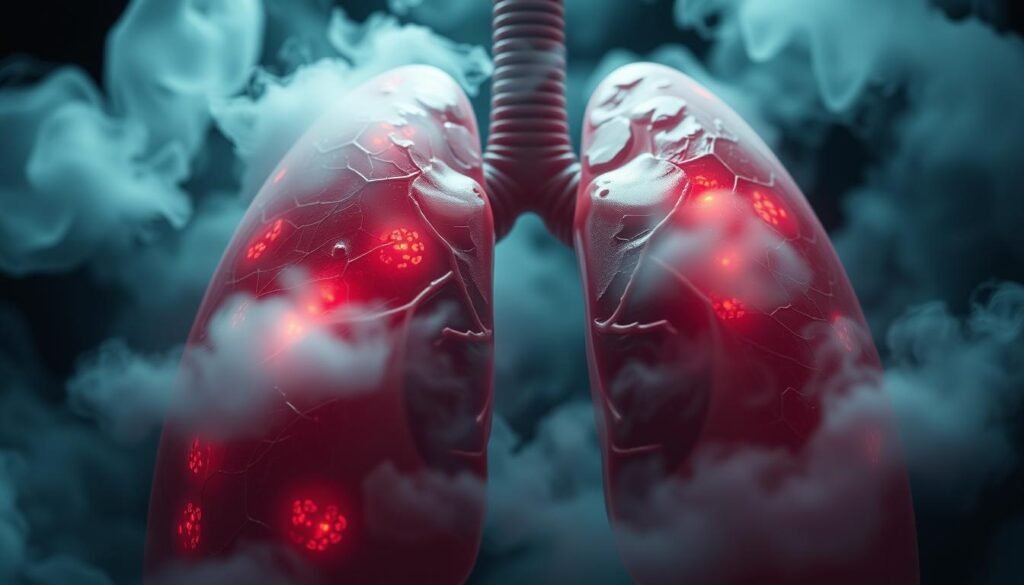An estimated 5% to 25% of lung cancer patients experience Radiation-induced Lung Injury (RILI) after radiation therapy. This makes recovery challenging for many. Every year, the United States sees about 200,000 new lung cancer cases. Unfortunately, up to 80% of these cases cannot be surgically removed. Therefore, it’s critical to manage respiratory issues after lung cancer radiation therapy to improve life after treatment. Handling these issues well can significantly impact a patient’s recovery.
The impact of RILI isn’t just physical. It also affects patients and caregivers emotionally and psychologically. Managing symptoms like breathing problems, trouble swallowing, and nausea quickly is key. Often, doctors suggest staying hydrated to ease some radiation therapy side effects. For hydration tips, check out this guide.
We’ll look into the different respiratory problems patients face after treatment. We’ll discuss how managing symptoms and getting support can help improve recovery and life quality.
Key Takeaways
- The incidence of radiation-induced lung injury varies significantly, especially in lung cancer patients.
- In the US, approximately 200,000 new lung cancer cases were reported in recent years.
- Staying hydrated is crucial in managing treatment side effects.
- Managing respiratory symptoms improves the overall quality of life.
- Timely intervention can help alleviate emotional stress associated with respiratory difficulties.
- Understanding the common side effects can help in better management of patient expectations.
Understanding Radiation-Induced Lung Injury
People getting radiation therapy, especially for lung cancer, face big challenges. Lung tissue can swell and get damaged from radiation. This damage often shows up as radiation pneumonitis. It usually shows up within a few months after treatment. Sometimes, it takes up to a year to appear.
What is Radiation Pneumonitis?
Radiation pneumonitis is a common inflammation caused by radiation therapy. It can make you cough and feel short of breath. Most people notice it within six months of their treatment. In fact, most cases happen within the first twelve weeks. 5% to 25% of lung cancer patients get radiation pneumonitis. Knowing when and what symptoms might occur is key to treating it early.
Long-Term Effects of Radiation: Lung Fibrosis
Long-term exposure to radiation can cause lung fibrosis. This means the lung tissue scars and lung function worsens over time. Lung fibrosis typically starts more than a year after therapy ends. The amount of healthy lung exposed to radiation and other lung problems can make things worse. Many lung cancer patients might develop lung fibrosis. It’s a serious problem from radiation therapy.
| Condition | Timeframe | Incidence | Symptoms |
|---|---|---|---|
| Radiation Pneumonitis | Within 6 months | 5% – 25% | Cough, Shortness of Breath |
| Lung Fibrosis | More than 1 year | Varies | Impaired Lung Function |
Knowing about radiation pneumonitis and lung fibrosis is crucial for those getting radiation therapy. Healthcare pros can improve outcomes with good management and prompt action. This helps reduce lung problems. Understanding this helps patients better manage their treatment and healing journey.
Signs and Symptoms to Watch For
After radiation therapy, it’s key to watch for signs that show lung trouble. Spotting symptoms early helps get quick and effective help. This makes handling any issues much easier.
Common Symptoms of Respiratory Issues
Keep an eye out for these symptoms after radiation treatment:
- Chronic cough: A cough that sticks around is a big sign of lung problems.
- Shortness of breath: If it’s hard to breathe, especially when you’re active, something might be wrong.
- Chest pain: Pain in the chest can mean there are more issues.
- Fever: A fever for no clear reason could point to lung issues.
- Malaise: Feeling generally unwell can also be a clue to bigger problems.

When to Seek Medical Attention
Get medical help right away if:
- It’s harder to breathe or your breath gets worse
- Your cough gets bad or happens more often
- You start feeling pain in your chest more or it’s new
- You have a fever that won’t go away and it’s with breathing problems
- There’s a big negative change in how you feel after treatment
Noticing these signs early is crucial. It means faster help from doctors. This quick action can stop other issues, like infections or blood clots. Getting help fast leads to better healing.
Respiratory Issues After Lung Cancer Radiation Therapy
After radiation therapy for lung cancer, patients might face several respiratory problems. It’s important to know why these issues occur for better management and treatment. Factors such as the radiation dose, the lung area treated, and other therapies like chemotherapy or immunotherapy play a role.
Causes of Respiratory Complications
Respiratory complications can arise from several factors, including:
- High radiation doses, especially over a large lung area.
- Chemotherapy alongside radiation, raising the chance of pneumonia and other issues.
- Existing health problems, like interstitial lung disease, that make radiation harm more likely.
- Older patients, over 70, face a greater risk of severe symptoms.
- A smoking history, which might unexpectedly reduce the risk of respiratory problems in some.
Identifying the Severity of Symptoms
It’s vital to know how severe respiratory symptoms are for quick action. Patients’ symptoms can range from mild irritation to severe issues. Look for these signs to gauge symptom severity:
| Symptom | Mild | Moderate | Severe |
|---|---|---|---|
| Cough | Occasional | Persistent | Barking or severe discomfort |
| Shortness of Breath | With exertion | At rest | Significant distress |
| Fever | Low-grade | Intermittent spikes | High fever |
| Chest Pain | Mild discomfort | Constant ache | Sharp pain or pressure |
If symptoms get worse or come with other worrying signs, get medical help quickly. Severe cases and symptoms that increase suddenly need checking to prevent serious issues like pneumonia or acute respiratory distress.
Diagnosing Respiratory Complications
It’s crucial to diagnose any breathing problems after lung cancer treatment. Doctors need a detailed plan to figure out what’s wrong. They use several tests to understand different causes of breathing issues.
Tests and Imaging Techniques
To find out what’s going on, doctors use lots of tests. They start with a physical check-up to look for clues. Then, CT scans give a closer look at the lungs. This helps doctors see where and how badly the lungs are hurt from the treatment.
Role of Pulmonary Function Tests
Pulmonary function tests are key for checking lung health. They show how well the lungs work and what problems might come up later. By doing these tests often, doctors can make sure they pick the right treatment to keep lungs healthy.
| Diagnostic Method | Purpose | Findings |
|---|---|---|
| Physical Examination | Initial assessment of respiratory symptoms | Cough, dyspnea, chest pain |
| CT Scan | Detailed imaging of lung structures | Potential lung damage, inflammation |
| Pulmonary Function Tests | Evaluation of lung capacity and efficiency | Assessment of lung function status |
Effective Treatment Options
After lung cancer radiation, managing respiratory problems is key. We focus on improving comfort and life quality. Approaches are personalized, considering patient needs and symptom severity. Medications and oxygen therapy are two effective treatments.
Medications for Symptom Management
Medications are crucial for managing respiratory issues post-radiation. Corticosteroids help by reducing lung inflammation. This eases coughing and breath shortness. Bronchodilators also play a big role. They relax the airways, making breathing easier. These medicines improve comfort and well-being for those with respiratory challenges.
Oxygen Therapy for Better Breathing
Oxygen therapy plays a vital part in treating breathing problems from lung damage post-radiation. It boosts blood oxygen levels, aiding those with breath shortness from radiation pneumonitis. Oxygen therapy improves daily activity engagement and life quality.
| Treatment Option | Purpose | Common Medications |
|---|---|---|
| Medications | Reduce inflammation and improve airflow | Corticosteroids, Bronchodilators |
| Oxygen Therapy | Increase oxygen levels in the blood | Oxygen delivery systems (nasal cannula, masks) |
Breathing Exercises for Recovery
Effective breathing exercises are crucial for those recovering from radiation therapy. They play a key role in respiratory recovery. These exercises improve lung health, help regain strength, and boost overall wellbeing.
Importance of Pulmonary Rehabilitation
Pulmonary rehab programs greatly help people looking to better their lung function after cancer treatments. They mix education with tailored exercise plans. This approach leads to more lung capacity and energy. People who exercise during and after their treatment often feel better overall. Simple breathing strategies also lessen symptoms and help with stress, making them key for complete recovery.
Simple Breathing Exercises to Incorporate
Adding these breathing exercises to your daily routine can greatly help your lungs:
- Diaphragmatic Breathing: This strengthens the diaphragm and increases lung capacity. Do it 5 times.
- Pursed-Lip Breathing: It helps control breathing, increasing lung efficiency.
- Quick Sniffles: This activates the lungs. Repeat it 3 times.
- Deep Breathing (4-8-8): Breathe in for 4 seconds, hold for 8, breathe out for 8. Do this 3 times.
- Shoulder Rolls: This improves movement and helps you relax. Do it 5 times.
- Shoulder Blade Squeezes: It improves your posture and lung function. Repeat 5 times.
- Overhead Chest Stretch: This increases lung space and promotes deep breathing. Do it 5 times.

These exercises only take 5 to 10 minutes a day. They’re easy to fit into your schedule and really benefit lung health. Doing them regularly not only boosts lung capacity but also supports respiratory recovery. This highlights the value of pulmonary rehab after cancer.
Dietary Considerations During Recovery
Nutrition is key for people getting treatment for lung cancer. It can boost lung health, lessen side effects, and improve well-being. Eating various nutrient-rich foods helps prevent weight loss and raises energy levels. This lets patients move through recovery more easily.
Foods to Aid Lung Health
To improve lung health, patients should eat a balanced diet that includes:
- Fruits and vegetables: These are full of antioxidants, boosting immune function and health.
- Lean proteins: Important for muscle, these can be found in chicken, turkey, fish, and legumes.
- Whole grains: They offer important carbs and nutrients. Brown rice and oats are good choices.
- Healthy fats: Omega-3 fats, especially from fish, help manage inflammation during treatment.
Adding these foods can help, especially if you have cancer cachexia. A dietitian can give you custom advice. They’ll ensure you’re eating right during treatment.
Hydration and Its Importance
Staying hydrated is critical for lung cancer patients. It makes mucus thinner, which makes breathing easier. Being well-hydrated helps treatments work better and fights off nausea and tiredness. To stay hydrated, patients should:
- Drink plenty of water all day.
- Get fluids from soups, broths, and herbal teas.
- Keep hydrated during and after exercise.
Keeping up with hydration is essential for both treatment success and recovery. For more info on hydration’s role, check out this useful resource.
Adjusting Lifestyle for Better Respiratory Health
Recovering from lung cancer means making big lifestyle changes to help your lungs. It’s important to avoid things that can hurt your lungs and to keep a healthy weight. These steps not only make you feel better but also help your lungs work better.
Importance of Avoiding Irritants
Avoiding irritants is key to better lung health. Things like smoke, pollution, and strong smells can make lung problems worse. To avoid these problems, try the following:
- Avoiding secondhand smoke and staying away from places with heavy pollution.
- Using air purifiers and keeping spaces clean to reduce dust and allergens.
- Choosing personal care products with fewer chemical irritants.
Maintaining a Healthy Weight
Keeping a healthy weight is crucial after lung cancer treatment. Eating right and staying active helps your lungs and gives you energy. Here are some tips:
- Incorporating fruits, vegetables, and lean proteins into meals to assist in recovery.
- Engaging in moderate physical activity regularly to keep weight in check.
- Staying hydrated to support overall health and respiratory function.

Making these lifestyle changes can boost your lung health and lower the chance of more problems. These new habits help you recover stronger and improve your life while you heal.
Quality of Life After Radiation Therapy
Recovering from lung cancer radiation therapy is a tough journey. It greatly affects the patient’s quality of life. Emotional support is crucial during this time. It helps individuals deal with anxiety and depression. Being part of a supportive network can lessen sadness and help the healing process. This improves the overall state of well-being.
Emotional and Psychological Support
Emotional and psychological support are key for those recovering from lung cancer radiation therapy. Many people go through ups and downs in their mental health. They may feel anxious or depressed. Finding community resources for counseling and therapy is really helpful. It makes coping easier. Support groups are also great because they let patients share stories and tips.
Community Resources and Support Groups
Community resources and support groups are super important for life after treatment. They offer many helpful services like:
- Patient counseling and mental health services
- Peer-led support groups creating a community
- Educational workshops about symptom management
- Help for those taking care of patients
Community resources provide emotional support. They help patients face challenges by bringing them together. This connection makes people feel not alone in their journey. It brings better mental health and strength.
| Community Resource | Services Offered | Contact Information |
|---|---|---|
| Lung Cancer Support Group | Peer support, resources, workshops | (123) 456-7890 |
| Mindfulness Therapy Center | Counseling, stress management | (234) 567-8901 |
| Local Cancer Society | Information, referrals, funded programs | (345) 678-9012 |
Future Directions in Managing Lung Health
Lung health management after radiation is getting better thanks to new innovations and studies. There’s a big push to improve treatments for patients. This includes high-precision techniques like Intensity-Modulated Radiotherapy (IMRT). IMRT is great because it’s effective and lowers pneumonia risks. These steps make treatments safer and more comfortable for patients.
Innovations in Treatment Approaches
Recent studies show benefits from mixing chemoradiotherapy with immune checkpoint inhibitors. This mix really helps in treating advanced lung cancer. It’s part of a bigger move towards therapies that are more personal. These target the cancer’s unique traits to work better and cause fewer side effects. Stereotactic body radiotherapy (SBRT) is now a key option for certain lung cancers. It improves control and has fewer severe side effects.
Research Developments in Radiation Therapy
There are new strategies in radiation therapy research, like particle beam therapy. In Japan, insurance now covers this for early-stage lung cancer patients. This is a big step in making advanced treatments more available. Techniques to manage breathing during therapy also improve precision. This shows a dedication to making cancer care technology better.
Conclusion
Managing lung health after lung cancer radiation is key for survivors. It helps them recover better. Radiation can cause lung problems like pneumonitis. So, it’s important to get the right medical care and act early to prevent side effects.
This kind of care can really improve life after treatment. Support for patients is crucial during treatment and healing. A team effort, including doctors, mental health support, and education, helps patients. It helps them face the challenges ahead. Knowing what causes lung issues after radiation helps in treating them better. This leads to improved health.
New research brings new ways to help patients. It’s important to understand how radiation harms lungs. Studies like those found here are key. They help create better treatments. By working together, we can create a caring space that focuses on recovery and health after lung cancer.